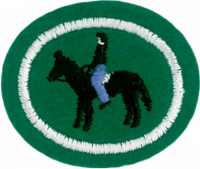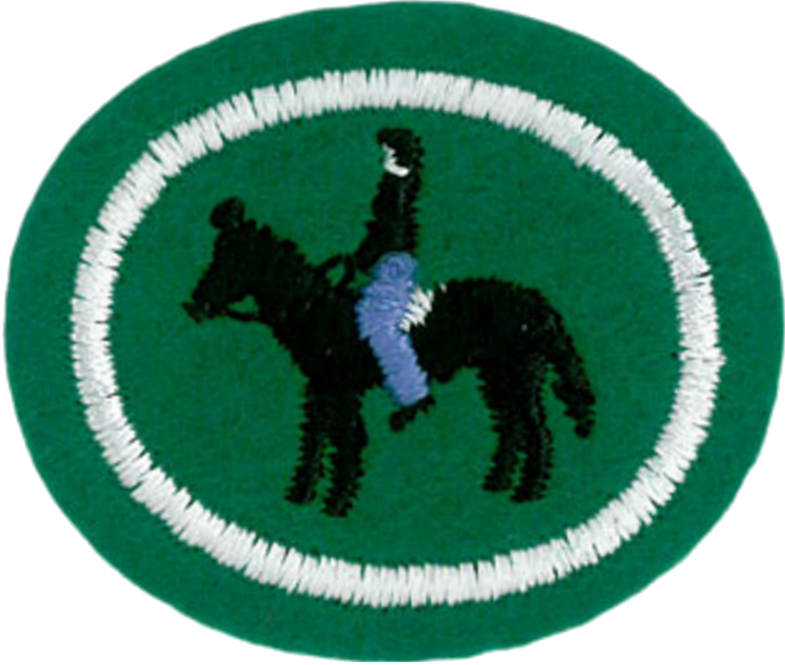Difference between revisions of "AY Honors/Horsemanship/Answer Key/es"
From Pathfinder Wiki
< AY Honors | HorsemanshipAY Honors/Horsemanship/Answer Key/es
(Created page with "</noinclude> {{honor_desc/es |stage=00 |honorname=Equitación |skill=1 |year=1961 |category=Actividades recreacionales |authority=Asociación General |insignia=Horsemanship_Ho...") |
(Updating to match new version of source page) |
||
| (28 intermediate revisions by 2 users not shown) | |||
| Line 1: | Line 1: | ||
| − | + | {{HonorSubpage}} | |
| − | + | <!--{{Honor_Master|honor=Horsemanship|master=Recreation}}--> | |
| − | {{ | + | <section begin="Body" /> |
| − | |||
| − | |||
| − | |||
| − | |||
| − | |||
| − | |||
| − | |||
| − | }} | ||
| − | |||
| − | {{Honor_Master | ||
| − | |||
| − | |||
| + | {{ansreq|page={{#titleparts:{{PAGENAME}}|2|1}}|num=Note|dispreq={{Localize|Note}}}} | ||
<noinclude></noinclude> | <noinclude></noinclude> | ||
| − | + | <!-- Nota: Todos los requisitos deben ser completados en un ambiente seguro con un caballo gentil. --> | |
| − | |||
| − | |||
| − | <!-- | ||
<noinclude></noinclude> | <noinclude></noinclude> | ||
{{CloseReq}} <!-- Note --> | {{CloseReq}} <!-- Note --> | ||
{{ansreq|page={{#titleparts:{{PAGENAME}}|2|1}}|num=1}} | {{ansreq|page={{#titleparts:{{PAGENAME}}|2|1}}|num=1}} | ||
<noinclude></noinclude> | <noinclude></noinclude> | ||
| − | <!-- 1. | + | <!-- 1. Etiquetar los nombres en un dibujo de un caballo, o señalar en un caballo vivo un mínimo de 15 diferentes pares del caballo. --> |
| − | |||
{{clear}} | {{clear}} | ||
| Line 33: | Line 18: | ||
{{ansreq|page={{#titleparts:{{PAGENAME}}|2|1}}|num=2}} | {{ansreq|page={{#titleparts:{{PAGENAME}}|2|1}}|num=2}} | ||
<noinclude></noinclude> | <noinclude></noinclude> | ||
| − | <!-- 2. | + | <!-- 2. Colocar/etiquetar los nombres en un dibujo o señalar una silla real y bridón: occidental –un mínimo de 10 partes de la silla de montar y 6 partes del bridón; inglés – un mínimo de 9 partes de la silla de montar y 7 partes del bridón. --> |
| − | |||
| − | |||
| − | |||
| − | |||
| − | |||
| − | |||
| − | |||
| − | |||
| − | |||
| − | |||
| − | |||
| − | |||
| − | |||
| − | |||
| − | |||
| − | |||
| − | |||
| − | |||
| − | |||
| − | |||
| − | |||
| − | |||
| − | |||
| − | |||
| − | |||
| − | |||
| − | |||
| − | |||
| − | |||
| − | |||
| − | |||
| − | |||
| − | |||
| − | |||
| − | |||
| − | |||
| − | |||
| − | |||
<noinclude></noinclude> | <noinclude></noinclude> | ||
| Line 77: | Line 24: | ||
{{ansreq|page={{#titleparts:{{PAGENAME}}|2|1}}|num=3}} | {{ansreq|page={{#titleparts:{{PAGENAME}}|2|1}}|num=3}} | ||
<noinclude></noinclude> | <noinclude></noinclude> | ||
| − | <!-- 3. | + | <!-- 3. Demostrar y explicar el propósito del equipo de seguridad, mientras se monta y trabaja alrededor de caballos de equitación, utilizando casco de equitación y botas (o zapatos de suela dura con tacón). --> |
| − | |||
| − | |||
| − | |||
<noinclude></noinclude> | <noinclude></noinclude> | ||
| Line 86: | Line 30: | ||
{{ansreq|page={{#titleparts:{{PAGENAME}}|2|1}}|num=4}} | {{ansreq|page={{#titleparts:{{PAGENAME}}|2|1}}|num=4}} | ||
<noinclude></noinclude> | <noinclude></noinclude> | ||
| − | <!-- 4. | + | <!-- 4. Demostrar y explicar un mínimo de cinco normas de seguridad para acercarse y guiar un caballo. --> |
| − | |||
| − | |||
| − | |||
| − | |||
| − | |||
| − | |||
<noinclude></noinclude> | <noinclude></noinclude> | ||
| Line 98: | Line 36: | ||
{{ansreq|page={{#titleparts:{{PAGENAME}}|2|1}}|num=5}} | {{ansreq|page={{#titleparts:{{PAGENAME}}|2|1}}|num=5}} | ||
<noinclude></noinclude> | <noinclude></noinclude> | ||
| − | <!-- 5. | + | <!-- 5. Demostrar y explicar un mínimo de cinco normas de seguridad para trabajar alrededor de los caballos. --> |
| − | |||
| − | |||
| − | |||
| − | |||
| − | |||
| − | |||
| − | |||
| − | |||
| − | |||
| − | |||
<noinclude></noinclude> | <noinclude></noinclude> | ||
| Line 114: | Line 42: | ||
{{ansreq|page={{#titleparts:{{PAGENAME}}|2|1}}|num=6}} | {{ansreq|page={{#titleparts:{{PAGENAME}}|2|1}}|num=6}} | ||
<noinclude></noinclude> | <noinclude></noinclude> | ||
| − | <!-- 6. | + | <!-- 6. Demostrar y explicar la preparación segura para peinar un caballo utilizando los cuatro instrumentos básicos – peine de la crin y cola, peine curry, cepillo rígido y cepillo suave. --> |
<noinclude></noinclude> | <noinclude></noinclude> | ||
| Line 120: | Line 48: | ||
{{ansreq|page={{#titleparts:{{PAGENAME}}|2|1}}|num=7}} | {{ansreq|page={{#titleparts:{{PAGENAME}}|2|1}}|num=7}} | ||
<noinclude></noinclude> | <noinclude></noinclude> | ||
| − | <!-- 7. | + | <!-- 7. Demostrar una forma segura de montar (incluyendo la revisión de ensillar) y desmontar. --> |
<noinclude></noinclude> | <noinclude></noinclude> | ||
{{CloseReq}} <!-- 7 --> | {{CloseReq}} <!-- 7 --> | ||
{{ansreq|page={{#titleparts:{{PAGENAME}}|2|1}}|num=8}} | {{ansreq|page={{#titleparts:{{PAGENAME}}|2|1}}|num=8}} | ||
<noinclude></noinclude> | <noinclude></noinclude> | ||
| − | <!-- 8. | + | <!-- 8. Demostrar equilibrio al estar sentado mientras monta un caballo caminando, incluyendo círculos y de retroceso. --> |
<noinclude></noinclude> | <noinclude></noinclude> | ||
{{CloseReq}} <!-- 8 --> | {{CloseReq}} <!-- 8 --> | ||
{{ansreq|page={{#titleparts:{{PAGENAME}}|2|1}}|num=9}} | {{ansreq|page={{#titleparts:{{PAGENAME}}|2|1}}|num=9}} | ||
<noinclude></noinclude> | <noinclude></noinclude> | ||
| − | <!-- 9. | + | <!-- 9. Demostrar y explicar cómo andar, detenerse, hacer círculos y retroceder utilizando las cuatro ayudas naturales – las piernas, las manos, la voz y el peso. --> |
<noinclude></noinclude> | <noinclude></noinclude> | ||
{{CloseReq}} <!-- 9 --> | {{CloseReq}} <!-- 9 --> | ||
{{ansreq|page={{#titleparts:{{PAGENAME}}|2|1}}|num=10}} | {{ansreq|page={{#titleparts:{{PAGENAME}}|2|1}}|num=10}} | ||
<noinclude></noinclude> | <noinclude></noinclude> | ||
| − | <!-- 10. | + | <!-- 10. Demostrar y explicar cinco normas de seguridad en los senderos, incluyendo las siguientes: --> |
<noinclude></noinclude> | <noinclude></noinclude> | ||
{{ansreq|page={{#titleparts:{{PAGENAME}}|2|1}}|num=10a}} | {{ansreq|page={{#titleparts:{{PAGENAME}}|2|1}}|num=10a}} | ||
<noinclude></noinclude> | <noinclude></noinclude> | ||
| − | + | {{clear}} | |
<noinclude></noinclude> | <noinclude></noinclude> | ||
| Line 146: | Line 74: | ||
{{ansreq|page={{#titleparts:{{PAGENAME}}|2|1}}|num=10b}} <!--T:11--> | {{ansreq|page={{#titleparts:{{PAGENAME}}|2|1}}|num=10b}} <!--T:11--> | ||
<noinclude></noinclude> | <noinclude></noinclude> | ||
| − | |||
<noinclude></noinclude> | <noinclude></noinclude> | ||
| Line 152: | Line 79: | ||
{{ansreq|page={{#titleparts:{{PAGENAME}}|2|1}}|num=10c}} <!--T:12--> | {{ansreq|page={{#titleparts:{{PAGENAME}}|2|1}}|num=10c}} <!--T:12--> | ||
<noinclude></noinclude> | <noinclude></noinclude> | ||
| − | |||
<noinclude></noinclude> | <noinclude></noinclude> | ||
| Line 163: | Line 89: | ||
<noinclude></noinclude> | <noinclude></noinclude> | ||
| − | + | {{clear}} | |
<noinclude></noinclude> | <noinclude></noinclude> | ||
| Line 174: | Line 100: | ||
{{ansreq|page={{#titleparts:{{PAGENAME}}|2|1}}|num=11}} | {{ansreq|page={{#titleparts:{{PAGENAME}}|2|1}}|num=11}} | ||
<noinclude></noinclude> | <noinclude></noinclude> | ||
| − | <!-- 11. | + | <!-- 11. Dar un paseo en un sendero por un mínimo de tres horas acumuladas siguiendo todas las normas de seguridad y el uso de la posición correcta. --> |
| − | + | {{clear}} | |
<noinclude></noinclude> | <noinclude></noinclude> | ||
{{CloseReq}} <!-- 11 --> | {{CloseReq}} <!-- 11 --> | ||
<noinclude></noinclude> | <noinclude></noinclude> | ||
| − | == | + | ==Referencias== |
| − | |||
| − | |||
<noinclude></noinclude> | <noinclude></noinclude> | ||
| − | + | ||
| + | [[Category:Instructor Required{{GetLangSuffix}}|{{SUBPAGENAME}}]] | ||
| + | {{CloseHonorPage}} | ||
Latest revision as of 21:33, 1 January 2023
Nota
Todos los requisitos deben ser completados en un ambiente seguro con un caballo gentil.
1
Etiquetar los nombres en un dibujo de un caballo, o señalar en un caballo vivo un mínimo de 15 diferentes pares del caballo.
2
Colocar/etiquetar los nombres en un dibujo o señalar una silla real y bridón: occidental –un mínimo de 10 partes de la silla de montar y 6 partes del bridón; inglés – un mínimo de 9 partes de la silla de montar y 7 partes del bridón.
3
Demostrar y explicar el propósito del equipo de seguridad, mientras se monta y trabaja alrededor de caballos de equitación, utilizando casco de equitación y botas (o zapatos de suela dura con tacón).
4
Demostrar y explicar un mínimo de cinco normas de seguridad para acercarse y guiar un caballo.
5
Demostrar y explicar un mínimo de cinco normas de seguridad para trabajar alrededor de los caballos.
6
Demostrar y explicar la preparación segura para peinar un caballo utilizando los cuatro instrumentos básicos – peine de la crin y cola, peine curry, cepillo rígido y cepillo suave.
7
Demostrar una forma segura de montar (incluyendo la revisión de ensillar) y desmontar.
8
Demostrar equilibrio al estar sentado mientras monta un caballo caminando, incluyendo círculos y de retroceso.
9
Demostrar y explicar cómo andar, detenerse, hacer círculos y retroceder utilizando las cuatro ayudas naturales – las piernas, las manos, la voz y el peso.
10
Demostrar y explicar cinco normas de seguridad en los senderos, incluyendo las siguientes:
10a
Estar atento al líder y alerta al peligro
10b
Usar correctamente la distancia
10c
No dejar que el caballo coma a lo largo del sendero
10d
Nunca ir más rápido que caminando por las superficies pavimentadas
10e
Siempre caminar con el caballo al acercarse o salir de un grupo de jinetes
10f
Usar la posición correcta para las colinas y los obstáculos
11
Dar un paseo en un sendero por un mínimo de tres horas acumuladas siguiendo todas las normas de seguridad y el uso de la posición correcta.


